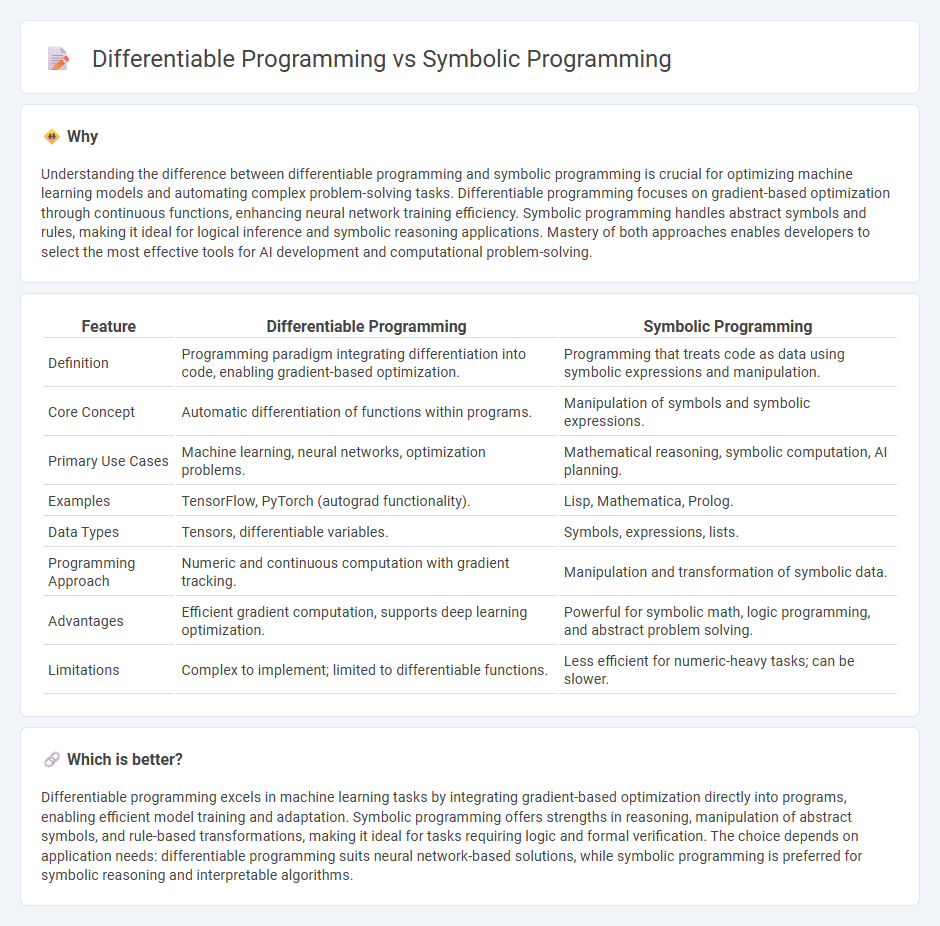
Differentiable programming integrates gradient-based optimization with traditional programming structures, enabling models to learn directly from data through differentiation. Symbolic programming manipulates symbols and expressions explicitly, focusing on logic and rule-based computations rather than numerical optimization. Explore how these paradigms impact machine learning and AI development by delving deeper into their unique approaches and applications.
Why it is important
Understanding the difference between differentiable programming and symbolic programming is crucial for optimizing machine learning models and automating complex problem-solving tasks. Differentiable programming focuses on gradient-based optimization through continuous functions, enhancing neural network training efficiency. Symbolic programming handles abstract symbols and rules, making it ideal for logical inference and symbolic reasoning applications. Mastery of both approaches enables developers to select the most effective tools for AI development and computational problem-solving.
Comparison Table
| Feature | Differentiable Programming | Symbolic Programming |
|---|---|---|
| Definition | Programming paradigm integrating differentiation into code, enabling gradient-based optimization. | Programming that treats code as data using symbolic expressions and manipulation. |
| Core Concept | Automatic differentiation of functions within programs. | Manipulation of symbols and symbolic expressions. |
| Primary Use Cases | Machine learning, neural networks, optimization problems. | Mathematical reasoning, symbolic computation, AI planning. |
| Examples | TensorFlow, PyTorch (autograd functionality). | Lisp, Mathematica, Prolog. |
| Data Types | Tensors, differentiable variables. | Symbols, expressions, lists. |
| Programming Approach | Numeric and continuous computation with gradient tracking. | Manipulation and transformation of symbolic data. |
| Advantages | Efficient gradient computation, supports deep learning optimization. | Powerful for symbolic math, logic programming, and abstract problem solving. |
| Limitations | Complex to implement; limited to differentiable functions. | Less efficient for numeric-heavy tasks; can be slower. |
Which is better?
Differentiable programming excels in machine learning tasks by integrating gradient-based optimization directly into programs, enabling efficient model training and adaptation. Symbolic programming offers strengths in reasoning, manipulation of abstract symbols, and rule-based transformations, making it ideal for tasks requiring logic and formal verification. The choice depends on application needs: differentiable programming suits neural network-based solutions, while symbolic programming is preferred for symbolic reasoning and interpretable algorithms.
Connection
Differentiable programming integrates gradient-based optimization techniques into programs, enabling machine learning models to learn from data through automatic differentiation. Symbolic programming manipulates symbols and expressions to represent and solve problems abstractly, often used in AI for reasoning and knowledge representation. The connection lies in hybrid approaches where symbolic programs incorporate differentiable components, enhancing interpretability and learning efficiency in complex AI systems.
Key Terms
Symbolic Expressions
Symbolic programming manipulates symbolic expressions to perform algebraic transformations and simplifications, enabling exact reasoning and formula derivation. Differentiable programming integrates differentiation within program execution, optimizing parameters through gradient-based methods often applied in neural networks. Explore the distinctions and applications of symbolic expressions in programming paradigms to deepen your understanding.
Automatic Differentiation
Symbolic programming manipulates expressions as mathematical symbols to perform exact algebraic computations, while differentiable programming leverages automatic differentiation (AD) to compute gradients efficiently for optimization tasks in machine learning. Automatic differentiation systematically applies the chain rule to compute derivatives of functions represented as code, enabling seamless gradient-based learning in neural networks. Discover how automatic differentiation bridges these approaches to enhance modern AI model training.
Program Manipulation
Symbolic programming excels in program manipulation by representing code as abstract syntax trees, enabling transformations, optimizations, and symbolic reasoning with explicit rule-based handling. Differentiable programming integrates gradient-based optimization within programs, allowing smooth parameter updates but relies on continuous differentiable structures rather than discrete symbolic transformations. Explore how these paradigms impact program manipulation and optimization techniques in modern AI systems.
Source and External Links
Symbolic Programming - Symbolic programming is a paradigm where programs can manipulate their own formulas and components as data, often used in AI and expert systems.
The Emergence and Evolution of the Symbolic Programming Paradigm - This page discusses the history and core principles of symbolic programming, including its application in various domains like robotics and cognitive science.
PyGlove: Symbolic Programming for Automated Machine Learning - This paper introduces PyGlove, a library that uses symbolic programming to automate machine learning tasks by manipulating ML programs symbolically.
 dowidth.com
dowidth.com